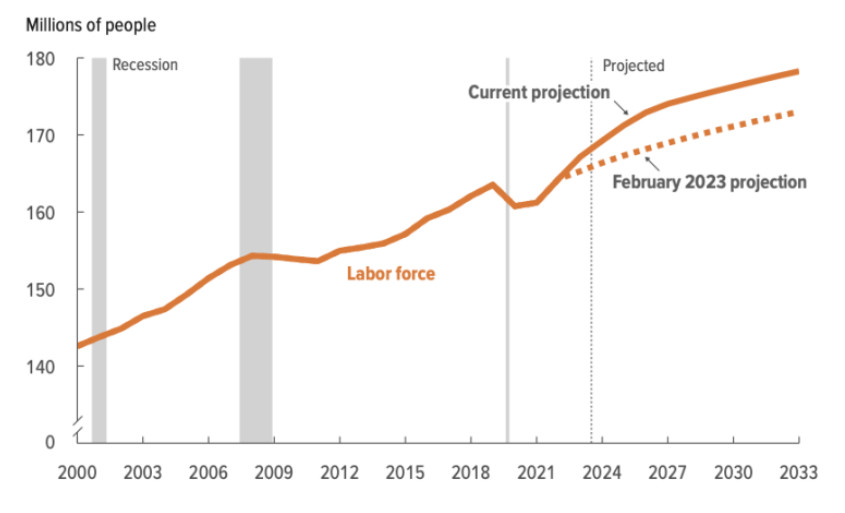CPI ဆိုတာ.. နာမည်ကြီး.. ပူလစ်ဇာရ နန်းပရောဖစ် အဖွဲ့ပါ..။ အဲဒီမှာ.. ဆောင်းပါးရှင်က.. သုံးသပ်တင်ပြထားတာဆိုပါစို့..။
ဆောင်းပါးအရ…
၁) အမေရိကန်လုပ်သားအင်အားက.. ကြီးထွားနေတာမှာ.. ၅.၂သန်းထပ်ဆောင်းမှာဖြစ်ပြီး.. အများစုက.. ပြောင်းခိုလာသူတွေပါတဲ့..။ သူတို့က.. တိုင်းပြည်ဂျီဒီပီကို.. ၂ %တိုးစေသတဲ့..။
၂) ပြောင်းခိုသူအလုပ်သမားတွေဟာ… အမေရိကစီးပွားရေးပေါ်ကို… လာမည့်ယ့်ဆယ်စုနှစ်ထဲ.. ဒေါ်လာ၇ ထရီလီယံ.. ထပ်ပေါင်းပေးမှာဖြစ်ပြီး.. ၁ထရီလီယံ ဒေါ်လာအခွန်ထမ်းဆောင်မှာ… တဲ့..။ ( ၁ ထရီလီယန် = ဘီလီယံ၁၀၀၀ )
၃) ကမ္ဘာ့တိုင်းပြည်ကြီးတွေ.. လူဦးရေကျုံ့သွားမှုနဲ့ကြုံကြရပေမယ့်…အသစ်ပြောင်းခိုလာသူတွေကြောင့်.. အမေရိကားလူဦးရေက. ၂၀၄၂အထိ.. .တိုးတက်နေမှာပါ… တဲ့..။
သူတို့တွက်တဲ့.. ပြောင်းရွေ့ခိုလှုံလာသူတွေထဲမှာ.. တရားဝင်ရော.. တရားမဝင်ရောပါပါတယ်..။ CBO’s 96-page report ( ကောမန့်မှာ.. ပီဒီအက်ဖ်) အရ.. ပြောင်းခိုသူလုပ်အားအင်အားတွေဟာ.. အမေရိကစီးပွားရေးနဲ့ ဘက်ဂျက်အပေါ် ဘယ်လောက်ထိ .. သက်ရောက်လဲပြထားပါတယ်..။
အဲဒါတွေသိတဲ့.. အမေရိကအစိုးရဟာ.. ကမ္ဘာအနှံ့က.. လုပ်အားအင်အားတွေကို.. DV ဆိုပြီး.. မဲဖေါက်ပြီးခေါ်… ကျောင်း/တက္ကသိုလ်တွေကို..နိုင်ငံခြားသားတွေအတွက်ဖွင့်ပေးထားပြီး.. ကျောင်းပြီးသူတွေကို… ဗီဇာစနစ်တွေလုပ်ပေး (OPT, H ) ပြီးသိမ်းသွင်း..။ ကျွမ်းကျင်တဲ့.. ပရိုတွေကို.. (H-1B, R-1, L-1) စသဖြင့်နဲ့ခေါ်နေတာပါ..။
ငွေရှိသူများအတွက်လည်း.. E-1/E-2/E-5 စသဖြင့်.. အဆင်သင့်..။
ပြီးခဲ့တဲ့.. တနှစ်ထဲ.. သမ္မတဘိုင်ဒင်လက်ထက်.. ရူးချင်ယောင်ဆောင်ပြီး.. နယ်စပ်ကိုဖွင့်.. လူ၂.၅သန်းကျော်သွင်းပလိုက်တာလည်း.. အဲဒီပေါ်လစီရဲ့အသီးအပွင့်ဖြစ်ကြောင်း .။
နယ်စပ်ကဝင်လာသူတွေဟာ.. ဟိုး.. တောင်နဲ့..လက်တင်အမေရိကကသူတွေများသမို့.. မိုင်ထောင်ချီခရီးကြမ်းကိုဖြတ်.. လာခဲ့ကြတာပါ..။ လွယ်လွယ်ဆိုရရင်.. ကျန်းမာရေးနဲ့.. ကြံ့ခိုင်မှုစစ်ဆေးပြီးအောင်ထားသူတွေဆိုပါတော့..။
သူတို့ကို.. နေခွင့်တန်းမပေးသေးပဲ.. ခိုလှုံခွင့်လျှောက်ခိုင်းပြီး.. ဒေတာ.. စာရင်းအတိအကျယူထားကြပါတယ်..။
မကြာမှီလာလတံ့သော.. တတိယကမ္ဘာစစ်ကြီးအတွက်.. အရံစစ်သားအင်အားများလည်း.. ဖြစ်နိုင်..။
ဘာပဲဖြစ်ဖြစ်.. မြန်မာနိုင်ငံက…စစ်အာဏာသိမ်းအုပ်စုဟာ.. လူငယ်/လူရွယ်တွေကို.. ကန်ထုတ်နေတုံးမှာ.. အမေရိကားကလည်း.. ခေါ်နေတာမို့… ဆီလိုရေလို… လူလိုအပေါက်ရှာ… အမေရိကားဝင်လာနိုင်ကြပါတယ်.. ဆိုတဲ့အကြောင်း…။
မြန်မာလူငယ်တွေ.. နည်းပေါင်းစုံသုံး.. ကြိုးစားနိုင်ကြ.. ကြိုးစားသင့်ပါတယ်.. ဆိုတဲ့အကြောင်း..။
( disclaimer – ဘာသာပြန်မဟုတ်..။ ဘာသာပြန်ရန်လိုင်စင်လည်းမရှိ..။ သတင်းသုံးသပ်ချက်ဖြစ်ကြောင်း)
Sitt Yoon May
New data shows why the U.S. needs more immigrants
An analysis by nonpartisan congressional economists shows how much the U.S. economy — and Social Security — depend on a growing immigrant workforce.
As the fight over immigration reached peak chaos in the U.S. Senate earlier this month, the Congressional Budget Office held a press conference nearby. The director’s briefing about the latest economic forecast seemed disconnected from the political drama playing out a few blocks away. But its analysis was closely linked to immigration policy.
The nonpartisan budget office, which estimates future tax revenue and government spending, continued projecting that the nation would spend trillions of dollars more than it brings in. The growing deficit is mainly the result of high interest rates, more people receiving Medicare and Social Security benefits, and rising healthcare costs. On top of that, revenue plunged after Republicans passed a law in 2017 that cut taxes for businesses and wealthy individuals.
Yet economists projected a smaller deficit and national debt than last year. One key reason is that they expect rising immigration to boost the U.S. economy.
Never miss an investigation
Subscribe to our free, weekly Watchdog newsletter to get the latest inequality news from Public Integrity.
Use the unsubscribe link in the emails to opt out at any time.
Here are some of the CBO’s most striking predictions for the next decade:
The U.S. labor force will grow by an extra 5.2 million workers, mostly because of increased immigration. They will boost the country’s Gross Domestic Product by a total of 2%.
Immigrant workers will add an extra $7 trillion to the U.S. economy within the next decade and an extra $1 trillion in federal tax revenue.
New immigrants will prevent the U.S. population from shrinking. They will be the source of all U.S. population growth by 2042.
The CBO’s 96-page report showed how much the U.S. economy and the national budget depend on immigrant workers. Their estimates include people who enter the country illegally and those who enter lawfully.
“We are continuing to assess the implications of immigration for revenues and spending,” Director Phillip Swagel said during the Feb. 7 briefing.

Much of the political discussion on immigration focuses on the record number of asylum seekers and undocumented immigrants who crossed the southern border last year.
Giovanni Peri, an economics professor at the University of California, Davis, said there are other reasons for the bump in immigration. Namely, the U.S. government began processing a backlog of applications in 2022 from foreigners seeking green cards and work permits that were put on hold during the COVID-19 pandemic.
The spike in immigration last year was not historic, Peri explained, but merely returned to pre-pandemic levels. He believes the most striking news from the CBO’s report was how clearly it stated that the U.S. population will start shrinking in 2042 without the expected increase in immigrant workers.
“It is saying that the growth of the U.S. labor force depends on immigrants in a fundamental way,” said Peri, whose research shows that the pandemic, plus strict immigration policies during the Trump administration, shrank the pool of working-age immigrants by 2 million.
More older workers decided to retire during the pandemic and the U.S.-born population is getting older, Peri’s research shows. Arriving immigrants are overwhelmingly younger and seeking work opportunities.
As more Americans retire, new immigrant workers will be largely responsible for expanding the labor force and funding Social Security.
The Social Security system has been in trouble for years. Payroll taxes on workers and businesses fund the benefits paid to millions of retired workers. But there are simply not enough people working to cover the cost.
In 1960, about 5.1 workers supported each person receiving a retirement or disability check, and that ratio has been shrinking ever since. In 2022, there were 2.8 workers for every beneficiary. So the current level of payroll taxes is no longer enough to keep the program afloat.
The federal government began dipping into its savings fund for retired workers a few years ago. And if nothing changes, that savings account will run dry by 2033, right around when the last of the baby boomers reach retirement age. After that, the government will only have enough money to pay retirees 77 cents for every dollar they’re owed.
The Social Security Administration has cited many reasons for the crisis, but it basically comes down to this: More Americans are retiring, and they are living longer. And American adults aren’t giving birth to enough children to replace all the retiring workers in the labor force.
The agency’s estimates show that immigration would help save the Social Security system. Not just legal immigration — illegal immigration too.
Undocumented immigrants and those with legal status pay billions of dollars each year into the Social Security system through payroll taxes. Based on estimates in a 2023 report from system trustees, the more immigrants that come in, the longer the Social Security system will stay solvent. That’s because immigrants, on average, are a lot younger than the overall U.S. population, so their retirement is far off. And many undocumented immigrants pay for Social Security, but they’re not allowed to get benefits.
Trustees for the Social Security system urged lawmakers earlier this year to increase payroll taxes, reduce benefits or both.
Increasing immigration would also help.
Help support this work
Public Integrity doesn’t have paywalls and doesn’t accept advertising so that our investigative reporting can have the widest possible impact on addressing inequality in the U.S. Our work is possible thanks to support from people like you.
